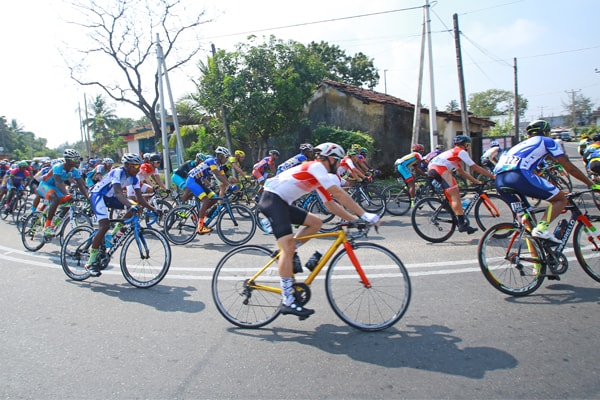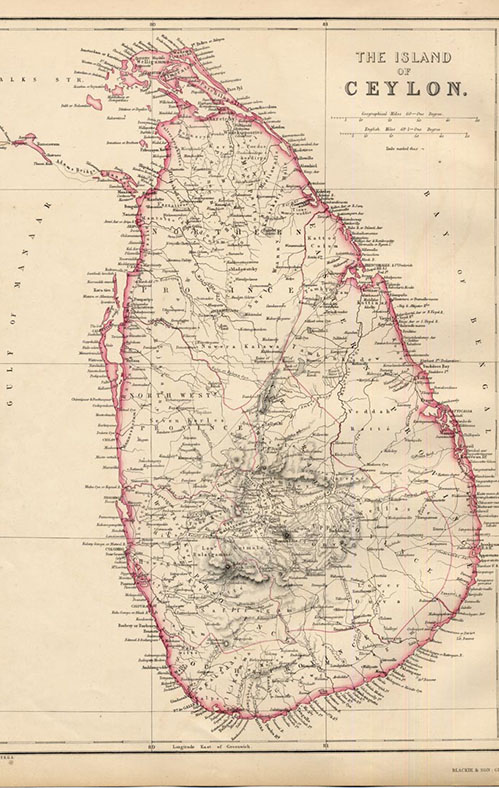 Most historians believe that the prince Vijaya came to Sri Lanka from Orissa, in north-eastern India, during the 6th century BC (some historians trace the origins back some 25,000 years) and started to rule the native people in Sri Lanka.
A nearly continuous written history exists in the book "Mahavamsa" from this point on and it describes the Sinhalese kingdom started from king Vijaya and his followers. It also describes a minister of Vijaya, Anuradha, who establishes the village of Anuradhagamma which later becomes Anuradhapura and becomes the capital of Sri Lanka a few centuries later. Archeological evidence is somewhat contradictory to this account, showing continuous settlement in the Anuradhapura area from the 10th century BC onwards with people living in the area having knowledge of agriculture, metallurgy, and livestock breeding.
Most historians believe that the prince Vijaya came to Sri Lanka from Orissa, in north-eastern India, during the 6th century BC (some historians trace the origins back some 25,000 years) and started to rule the native people in Sri Lanka.
A nearly continuous written history exists in the book "Mahavamsa" from this point on and it describes the Sinhalese kingdom started from king Vijaya and his followers. It also describes a minister of Vijaya, Anuradha, who establishes the village of Anuradhagamma which later becomes Anuradhapura and becomes the capital of Sri Lanka a few centuries later. Archeological evidence is somewhat contradictory to this account, showing continuous settlement in the Anuradhapura area from the 10th century BC onwards with people living in the area having knowledge of agriculture, metallurgy, and livestock breeding.
Buddhism arrived from the subcontinent 300 years after Vijaya of Orissa at the hands of Mahinda Thero and spread rapidly. Buddhism and a sophisticated system of irrigation became the pillars of classical Sinhalese civilization (200 BC-1200 AD) that flourished in the north-central part of the island, with capitals at Anuradhapura (from c. 200 BC to c. 1000 AD) and Polonnaruwa (c. 1070 to 1200).
The origins of Tamil presence on the island are unclear. Given the island's close proximity to the South India, it is very likely that people have traveled back and forth throughout human history.
South Indian rulers attacked Sri Lanka on a number of occasions. Occasionally, such invasions resulted in Tamil rule of the island for extended periods. Several Sinhala kings are noted for driving back the Tamil invasions and retaking the capital.
After the Polonnaruwa kingdom, the Sinhalese capital moved between several cities over the next centuries, partially to circumvent foreign invasion. The capital has settled in Sri Jayewardenepura (Kotte) when coastal regions were occupied by the Portuguese in the 16th century. The Portuguese were followed by the Dutch in the 17th century. During both Portuguese and Dutch rule of the coastal areas, the interior, hilly region of the island remained independent, with its capital, the city of Kandy. Great Britain replaced the Dutch in 1796, and the coastal areas became a crown colony in 1802. The entire island became part of the British Empire in 1815.
During the World War II the Japanese forces bombed Sri Lanka, but there were only few casualties.
As Ceylon [1], it became independent in 1948. In 1972, its name was changed to Sri Lanka, and in 1978 the legislative and judicial capital was moved from Colombo to nearby Sri Jayewardanapura Kotte. The flag was also changed as orange and green vertical bars were added, representing the Tamil and Muslim minority populations.
Post independence governments implemented a series of pro-Sinhalese measures in order to support the majority community who were disadvantaged compared to the minorities due to the policies of European colonialists. This was seen as discriminatory by the Tamils and lead to tensions between the Sri Lankan government and the Tamil politial/military groups which erupted in violence in 1983 following the killing of 13 soldiers of the Sri Lankan Army in Jaffna. This led to communal riots throughout the country and resulted in the deaths of hundreds of Tamils over a three-day period; many more became refugees. Sinhalese were driven away from the North by militants and the Tamils in the South continue to face severe difficulties in their daily lives. Tens of thousands have died on both sides in the subsequent ethnic war that continues to fester.
After two decades of fighting, the Liberation Tigers of Tamil Eelam and the government began a ceasefire in December 2001. Norway is mediating the peace process. The international anti-terrorism focus may have influenced the main Tamil rebel group to seek the ceasefire, as the LTTE was declared a terrorist organization by the United States of America, the United Kingdom, Australia, India, Canada and Sri Lanka. On December 26, 2004, one of the deadliest natural disasters in modern history, the Indian Ocean earthquake, struck off the western coast of Sumatra. The earthquake and subsequent tsunamis reportedly killed over 220,000 people around the rim of the Indian Ocean. The impact on Sri Lanka was severe. The south and east coasts were devastated by the 10-metre high tsunami, and tens of thousands died.
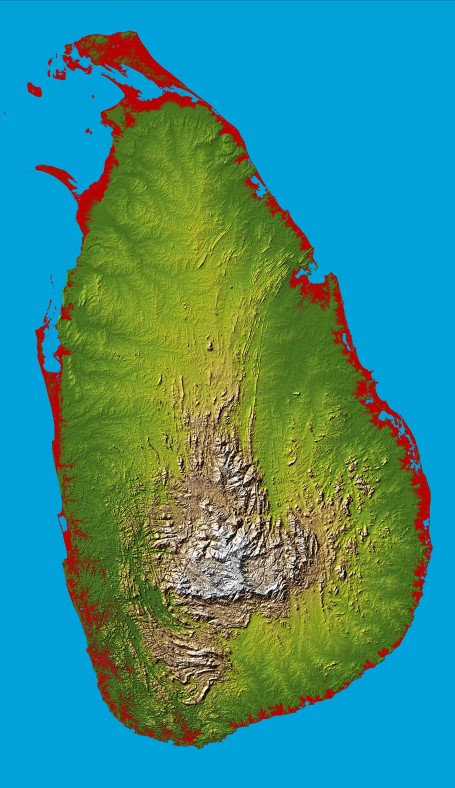 The island of Sri Lanka, lies within the Indian Ocean, with the Bay of Bengal to the northeast. It is separated from the Indian subcontinent by the Gulf of Mannar and the Palk Strait. According to Hindu mythology, a land bridge to the Indian mainland, known as Adam's Bridge, was constructed during the rule of Rama. It is now mostly submerged, with only a chain of limestone shoals remaining above sea level. According to temple records this natural causeway was formerly complete, but was breached by a violent storm (probably a cyclone) in 1480.
The island of Sri Lanka, lies within the Indian Ocean, with the Bay of Bengal to the northeast. It is separated from the Indian subcontinent by the Gulf of Mannar and the Palk Strait. According to Hindu mythology, a land bridge to the Indian mainland, known as Adam's Bridge, was constructed during the rule of Rama. It is now mostly submerged, with only a chain of limestone shoals remaining above sea level. According to temple records this natural causeway was formerly complete, but was breached by a violent storm (probably a cyclone) in 1480.
The pear-shaped island consists mostly of flat-to-rolling coastal plains, with mountains rising only in the south central part of the island. Amongst these, are Adam's Peak and Pidurutalagala, the latter being the highest point at 2,524 m.
The Sri Lankan climate is tropical, characterized by monsoons: the northeast monsoon lasting from December to March, and the southwest monsoon from June to October. The lowest gravitational field on Earth lies just off the coast of Sri Lanka. Sigiriya is considered the 8th wonder of the world.
The commercial capital is Colombo, but the administrative and legislative capital is located in nearby Sri Jayewardanapura (Kotte). Other major cities include
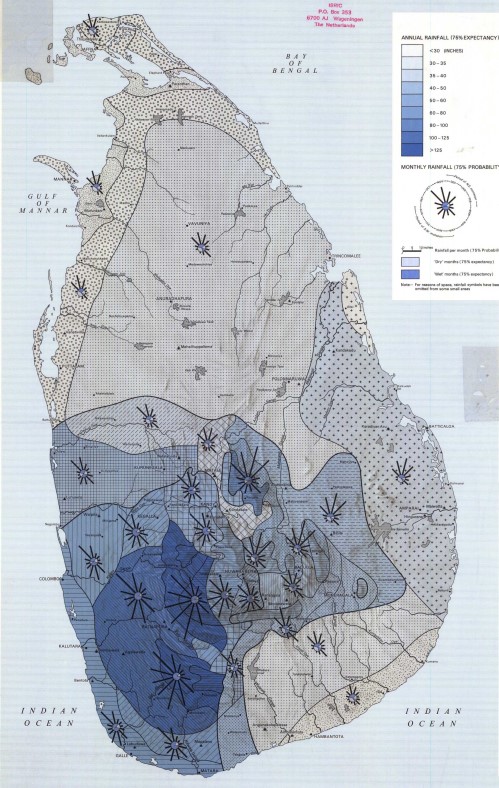 Sri Lanka is one of the world's bio-diversity hot-spots. Its forests are amongs the most floristically rich in Asia and for some faunal groups, it has the highest density of species diversity in the world. The southwest portion of the island, where the influence of the moisture-bearing southwest monsoon is strongest, is home to the Sri Lanka lowland rain forests. At higher elevations they transition to the Sri Lanka montane rain forests. Both these tropical moist forest ecoregions bear strong affinities to those of India's Western Ghats.
Sri Lanka is one of the world's bio-diversity hot-spots. Its forests are amongs the most floristically rich in Asia and for some faunal groups, it has the highest density of species diversity in the world. The southwest portion of the island, where the influence of the moisture-bearing southwest monsoon is strongest, is home to the Sri Lanka lowland rain forests. At higher elevations they transition to the Sri Lanka montane rain forests. Both these tropical moist forest ecoregions bear strong affinities to those of India's Western Ghats.
The northern and eastern portions of the island are considerably drier, lying in the rain shadow of the central highlands. The Sri Lanka dry-zone dry evergreen forests are a tropical dry broadleaf forest ecoregion, which, like the neighboring East Deccan dry evergreen forests of India's Coromandel Coast, is characterized by evergreen trees, rather than the dry-season deciduous trees that predominate in most other tropical dry broadleaf forests.
These forests have been largely cleared for agriculture, timber or grazing, and many of the dry evergreen forests have been degraded to thorn scrub, savanna, or thickets. Several preserves have been established to protect some of Sri Lanka's remaining natural areas. The island has three biosphere reserves, Hurulu (established 1977), Sinharaja (established 1978), and Kanneliya-Dediyagala-Nakiyadeniya (KDN) (established 2004).
Sri Lanka is a centre of bird endemism. See Endemic Birds of the Indian Subcontinent for further information.
 Sri Lanka is historically famous for its cinnamon and tea (introduced by the British in the 19th century). From independence, till 1977, it was a strongly socialist economy but since then it has been increasingly pursuing privatization, market-oriented policies and export-oriented trade. While tea and rubber are still important, the most dynamic sectors are now food processing, textiles and apparel, food and beverages, telecommunications, insurance, and banking. By 1996, plantation crops made up only 20 percent of exports (compared with 93 percent in 1970), while textiles and garments accounted for 63 percent.
Sri Lanka is historically famous for its cinnamon and tea (introduced by the British in the 19th century). From independence, till 1977, it was a strongly socialist economy but since then it has been increasingly pursuing privatization, market-oriented policies and export-oriented trade. While tea and rubber are still important, the most dynamic sectors are now food processing, textiles and apparel, food and beverages, telecommunications, insurance, and banking. By 1996, plantation crops made up only 20 percent of exports (compared with 93 percent in 1970), while textiles and garments accounted for 63 percent.
The GDP grew at an average annual rate of 5.5 percent during the early 1990s, until a drought and a deteriorating security situation lowered growth to 3.8 percent in 1996. The economy rebounded in 1997-2000, with average growth of 5.3 percent. 2001 saw the first economic contraction in the country's history, due to a combination of power shortages, budgetary problems, the global slowdown, and continuing civil strife. Signs of recovery appeared after the government and the LTTE signed the 2002 ceasefire. The Colombo stock exchange reported the highest growth in Asia for 2003, and today Sri Lanka has the highest per capita income in South Asia.
In April 2004, there was a sharp reversal in economic policy after the government headed by Ranil Wickremesinghe from the United National Party was defeated by a coalition made up of Sri Lanka Freedom Party and the left-nationalist Janatha Vimukthi Peramuna called the United People's Freedom Alliance.
The new government stopped the privatization of state enterprises, reforms of state utilities such as power and petroleum and embarked on an unprecedented subsidy program. The main themes of what was called the Rata Perata economic program was to support the rural and suburban SMEs and insulate the domestic economy from external influences, such as oil prices, the World Bank and the International Monetary Fund.
However a policy of directly subsidizing imported commodities like fuel, fertilizer and wheat, soon unravelled the fiscal sector. In 2004 alone Sri Lanka spent approximately US $ 180 mn on a fuel subsidy as fixing fuel prices was an election promise.
To finance the expanded budget deficit arising from a range of subsidies and a public sector recruitment drive the government eventually had to print Rs 65 bn (US $ 65 mn) or around 3 percent of GDP. The expansionary fiscal policy, coupled with loose monetary policy eventually drove inflation up to 18% by January 2005, as measured by the Sri Lanka Consumer Price Index.
By December 2004, the country was heading for a balance of payments crisis, as the currency depreciated and reserves dwindled. The December 26th Tsunami brought aidflows, and support from the IMF helped improve sentiment in the foreign exchange market.
But GDP growth, which had climbed to 6.4% by the first quarter of 2004 had fallen to 4.8% by the first quarter of 2005.
The tsunami helped stabilize the deterioration of macro-economic fundamentals as foreign debt relief and assistance from the International Monetary Fund strengthened both the external sector and fiscal operations.
GDP growth in 2Q 2005 is expected to be higher, but inflation remains in double digits. Continued subsidies on oil (and thermal generated power) are beginning to put pressure on exchange rates again. Loose monetary policy has also been driving credit growth.
The IMF in a report released in September 2005 has called for and end to 'fiscal domination' of monetary policy and more independance for the Central Bank so that inflation could be contained.
The government is now seeking an international credit rating, with S & P, Moody's and Fitch Ratings being appointed to rate the country before the end of 2005.
 About 74 percent of the population belongs to the Sinhalese majority, which is predominantly Buddhist, mostly following the Theravada tradition. The other major group on the island is the Tamils, who constitute 18 percent of the population. They are predominantly Hindu, and live mostly in the north, east and central provinces of Sri Lanka. The Tamil population comprises two communities, one composed of Native Tamils and another composed of more recent immigrants from India.
About 74 percent of the population belongs to the Sinhalese majority, which is predominantly Buddhist, mostly following the Theravada tradition. The other major group on the island is the Tamils, who constitute 18 percent of the population. They are predominantly Hindu, and live mostly in the north, east and central provinces of Sri Lanka. The Tamil population comprises two communities, one composed of Native Tamils and another composed of more recent immigrants from India.
Both Sinhala and Tamil languages have enjoyed official status since the Indo-Lanka accord in 1987, which resulted in the 13th amendment to the constitution. English, the link language in the present constitution, is the mother tongue of roughly 10 percent of the population, and is spoken and understood widely. All three languages are used in education and administration.
Smaller minorities include the (mostly Sunni) Muslims (7%), mostly of Arab and Malay descent , the Burghers of mixed European descent (1%) and the Wanniyala-Aetto or Veddahs, the few remaining descendants of earlier cultures. Buddhism (70%) and Hinduism (15%) are the dominant religions. Christians represent 7% of the population, including 6% Catholics and 1% Protestants.

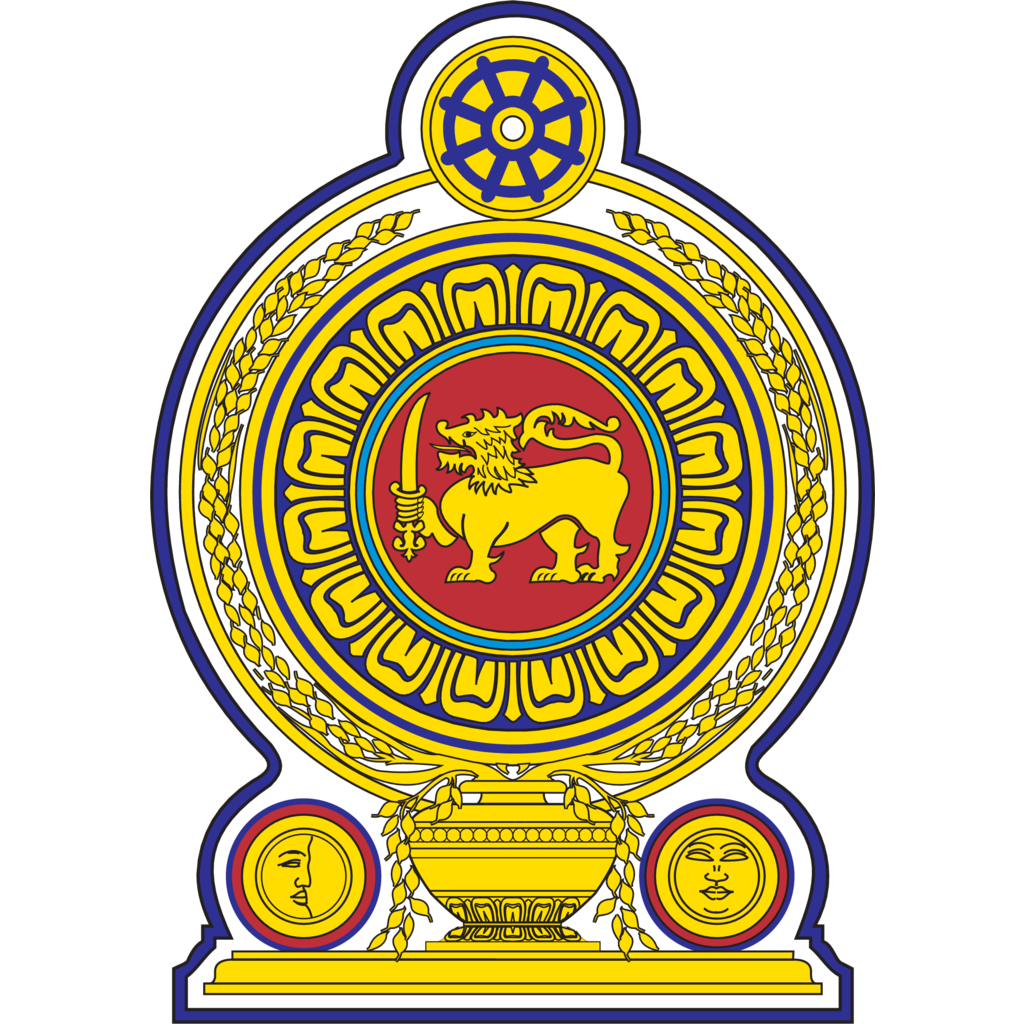
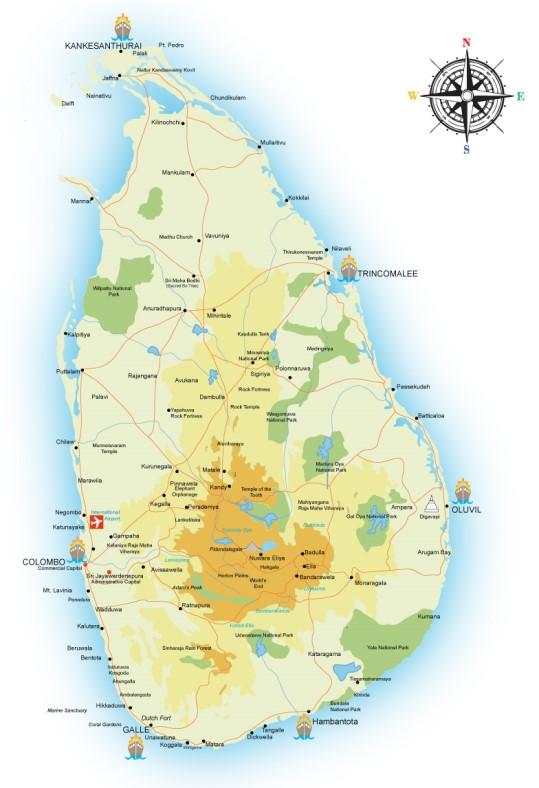


 Most historians believe that the prince Vijaya came to Sri Lanka from Orissa, in north-eastern India, during the 6th century BC (some historians trace the origins back some 25,000 years) and started to rule the native people in Sri Lanka.
A nearly continuous written history exists in the book "Mahavamsa" from this point on and it describes the Sinhalese kingdom started from king Vijaya and his followers. It also describes a minister of Vijaya, Anuradha, who establishes the village of Anuradhagamma which later becomes Anuradhapura and becomes the capital of Sri Lanka a few centuries later. Archeological evidence is somewhat contradictory to this account, showing continuous settlement in the Anuradhapura area from the 10th century BC onwards with people living in the area having knowledge of agriculture, metallurgy, and livestock breeding.
Most historians believe that the prince Vijaya came to Sri Lanka from Orissa, in north-eastern India, during the 6th century BC (some historians trace the origins back some 25,000 years) and started to rule the native people in Sri Lanka.
A nearly continuous written history exists in the book "Mahavamsa" from this point on and it describes the Sinhalese kingdom started from king Vijaya and his followers. It also describes a minister of Vijaya, Anuradha, who establishes the village of Anuradhagamma which later becomes Anuradhapura and becomes the capital of Sri Lanka a few centuries later. Archeological evidence is somewhat contradictory to this account, showing continuous settlement in the Anuradhapura area from the 10th century BC onwards with people living in the area having knowledge of agriculture, metallurgy, and livestock breeding.
 The island of Sri Lanka, lies within the Indian Ocean, with the Bay of Bengal to the northeast. It is separated from the Indian subcontinent by the Gulf of Mannar and the Palk Strait. According to Hindu mythology, a land bridge to the Indian mainland, known as Adam's Bridge, was constructed during the rule of Rama. It is now mostly submerged, with only a chain of limestone shoals remaining above sea level. According to temple records this natural causeway was formerly complete, but was breached by a violent storm (probably a cyclone) in 1480.
The island of Sri Lanka, lies within the Indian Ocean, with the Bay of Bengal to the northeast. It is separated from the Indian subcontinent by the Gulf of Mannar and the Palk Strait. According to Hindu mythology, a land bridge to the Indian mainland, known as Adam's Bridge, was constructed during the rule of Rama. It is now mostly submerged, with only a chain of limestone shoals remaining above sea level. According to temple records this natural causeway was formerly complete, but was breached by a violent storm (probably a cyclone) in 1480.
 Sri Lanka is one of the world's bio-diversity hot-spots. Its forests are amongs the most floristically rich in Asia and for some faunal groups, it has the highest density of species diversity in the world. The southwest portion of the island, where the influence of the moisture-bearing southwest monsoon is strongest, is home to the Sri Lanka lowland rain forests. At higher elevations they transition to the Sri Lanka montane rain forests. Both these tropical moist forest ecoregions bear strong affinities to those of India's Western Ghats.
Sri Lanka is one of the world's bio-diversity hot-spots. Its forests are amongs the most floristically rich in Asia and for some faunal groups, it has the highest density of species diversity in the world. The southwest portion of the island, where the influence of the moisture-bearing southwest monsoon is strongest, is home to the Sri Lanka lowland rain forests. At higher elevations they transition to the Sri Lanka montane rain forests. Both these tropical moist forest ecoregions bear strong affinities to those of India's Western Ghats.
 Sri Lanka is historically famous for its cinnamon and tea (introduced by the British in the 19th century). From independence, till 1977, it was a strongly socialist economy but since then it has been increasingly pursuing privatization, market-oriented policies and export-oriented trade. While tea and rubber are still important, the most dynamic sectors are now food processing, textiles and apparel, food and beverages, telecommunications, insurance, and banking. By 1996, plantation crops made up only 20 percent of exports (compared with 93 percent in 1970), while textiles and garments accounted for 63 percent.
Sri Lanka is historically famous for its cinnamon and tea (introduced by the British in the 19th century). From independence, till 1977, it was a strongly socialist economy but since then it has been increasingly pursuing privatization, market-oriented policies and export-oriented trade. While tea and rubber are still important, the most dynamic sectors are now food processing, textiles and apparel, food and beverages, telecommunications, insurance, and banking. By 1996, plantation crops made up only 20 percent of exports (compared with 93 percent in 1970), while textiles and garments accounted for 63 percent.
 About 74 percent of the population belongs to the Sinhalese majority, which is predominantly Buddhist, mostly following the Theravada tradition. The other major group on the island is the Tamils, who constitute 18 percent of the population. They are predominantly Hindu, and live mostly in the north, east and central provinces of Sri Lanka. The Tamil population comprises two communities, one composed of Native Tamils and another composed of more recent immigrants from India.
About 74 percent of the population belongs to the Sinhalese majority, which is predominantly Buddhist, mostly following the Theravada tradition. The other major group on the island is the Tamils, who constitute 18 percent of the population. They are predominantly Hindu, and live mostly in the north, east and central provinces of Sri Lanka. The Tamil population comprises two communities, one composed of Native Tamils and another composed of more recent immigrants from India.



